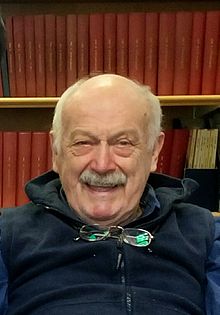Andrew N. Schofield
Andrew Noel Schofield | |
|---|---|
 Andrew Schofield in 2016 | |
| Born | 1 November 1930 England |
| Nationality | English |
| Alma mater | Cambridge University, UK |
| Known for | Critical state soil mechanics, Cam Clay, Geotechnical centrifuge modelling |
| Spouse | Margaret Green (m.1961) |
| Awards | US Army Distinguished Civilian Service Award, 1979 20th Rankine Lecture, 1980 Fellow[1] of the Royal Academy of Engineering,[2] 1986 Fellow of the Royal Society, 1992 James Alfred Ewing Gold Medal from the Institution of Civil Engineers, 1993 |
| Scientific career | |
| Fields | Soil Mechanics, Geotechnical Engineering |
| Institutions | Cambridge University, UK University of Manchester Institute of Science and Technology (UMIST) |
| Thesis | The development of lateral force during the displacement of sand by the vertical face of a rotating model foundation (1960) |
| Doctoral advisor | Kenneth H. Roscoe[3] |
| Notable students | Malcolm D. Bolton, Robert Mair, Sarah Springman |
Andrew Noel Schofield FRS[4] FREng[5] (born 1 November 1930) is a British soil mechanics engineer and an emeritus professor of geotechnical engineering at the University of Cambridge.
Life
Schofield was born on 1 November 1930, son of Rev John Noel Schofield and Winifred Jane Mary Eyles in Cambridge, England. He married Margaret Eileen Green in 1961 (Black 2010). He retired from Cambridge University in 1997.
Career
Andrew Schofield studied engineering and graduated from Christ's College, Cambridge in 1951 (Schofield 2005). He then worked in the Nyasaland Protectorate, Africa (now Malawi) office of Scott and Wilson Ltd. where he performed research on lateritic soils and low cost road construction (Rowe 1980). He returned to Cambridge University to work with Professor Kenneth H. Roscoe on his PhD, which he completed in 1961 (Rowe 1980). He became an Assistant Lecturer in 1961 and a Fulbright Fellow and a California Institute of Technology Fellow in 1963/4.[6] He was elected Fellow of Churchill College, Cambridge in 1964.[7] He was elected as a Fellow[8] of the Royal Academy of Engineering[9] in 1986 and as a Fellow of the Royal Society in 1992.[10]
With Ken Roscoe and Peter Wroth in 1958 he published "On the Yielding of Soils", which showed how plasticity theory and critical state soil mechanics could be used to describe the coupled volumetric and shear behavior of soils. (Roscoe, Schofield & Wroth 1958) led to the development of a constitutive model known as 'Cam Clay' that was formalized in the classic text by (Schofield & Wroth 1968).
Schofield was influenced by work on geotechnical centrifuge modeling by G.I. Pokrovsky in the USSR (Schofield 2005) to study geotechnical engineering and soil mechanics problems. He developed a prototype geotechnical centrifuge in Cambridge and later adapted a centrifuge in the English Electric Company in Luton, UK to be used for geotechnical modelling in 1966 (Rowe 1980), (Schofield 2005).
He accepted a Chair at the Institute of Science and Technology in Manchester (UMIST) in 1968 and developed a 1.5 m radius geotechnical centrifuge there (Rowe 1980), (Schofield 2005). Following Roscoe's untimely death in 1970, he returned to Cambridge in 1974 and was appointed as a Professor in the Cambridge University Engineering Department to lead the Soil Mechanics group (Rowe 1980). Working with a mechanical design engineer, Phillip Turner, he developed a 5 m radius geotechnical centrifuge at Cambridge University that continues to be heavily used in 2010. He was elected a Fellow of the Royal Society in 1992. Professor Schofield retired from the University in 1997, but his continued work is evidenced by the publication of a book in 2005 (Schofield 2005).
Major Publications
- Roscoe, K. H.; Schofield, A. N.; Wroth, C. P. (1958), "On the Yielding of Soils", Geotechnique, vol. 8, pp. 22–53
- Schofield, A. N.; Wroth, C. P. (1968), Critical State Soil Mechanics, McGraw-Hill, p. 310, ISBN 978-0641940484
- Schofield, A. N. (2005), Disturbed soil properties and geotechnical design, Thomas Telford, p. 216, ISBN 978-0727729828
- Schofield, A. N. (1980), "Cambridge geotechnical centrifuge operations", Geotechnique, vol. 30, no. 3, pp. 227–268
References
- ^ "List of Fellows".
- ^ "List of Fellows".
- ^ Andrew N. Schofield at the Mathematics Genealogy Project
- ^ "Andrew Schofield - Royal Society". Royal Society. Retrieved 20 March 2016.
- ^ "List of Fellows".
- ^ {{cite Directory of Visiting Scholars in the United States 1963-1964, Fulbright Visiting Scholar Program, Council for International Exchange of Scholars (CIES) Washington, DC, US}}
- ^ "Master, Fellows and By-Fellows".
- ^ "List of Fellows".
- ^ "List of Fellows".
- ^ "Fellowship Directory".
Further reading
- Rowe, P.W. (1980), "The Rankine Lecture", Geotechnique, vol. 30, no. 3, p. 225
- Schofield, A. N. (2005), Disturbed soil properties and geotechnical design, Thomas Telford, p. 216, ISBN 978-0727729828
- Black, A & C (2010), Who's Who 2011, Oxford University Press, ISBN 9780199572151, retrieved 6 December 2010
External links
- [Andrew Schofield's webpage http://www2.eng.cam.ac.uk/~ans/ans1.htm] on Cambridge University website
